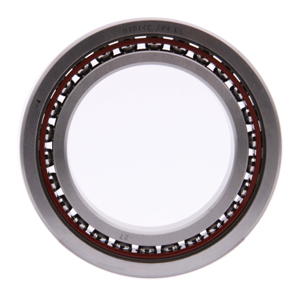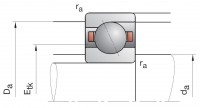spindle bearing
|
|
High-speed spindle bearings further improve the mechanical and thermodynamic load-bearing capacity of the electric spindle through optimized design, and greatly improve the productivity and competitiveness of customers. High-speed spindle bearings perfectly combine the high-speed performance of the small ball series with the rigidity and load-bearing capacity of the large ball series by selecting the appropriate ball diameter, tightness and internal radial clearance. The small ball bearing series usually used in motor spindle have a large contact angle, which can effectively prevent thermal limitation during operation. Bearing with 25° contact angle can support higher axial forces than 15° contact angle.
While the CNC machine tool spindle is developing in the direction of high speed and precision, it is required to improve its processing accuracy and production efficiency. The key to realizing these technologies is closely related to high-speed precision bearing technology. At the same time, in order to meet the requirements of high stiffness and low temperature rise of the spindle, the multi-link back-to-back assembly structure of angular contact ball bearings is often used to increase the support span and stiffness of the spindle bearing. In order to achieve more superior performance of the electric spindle, hybrid ceramic ball bearings are widely used in electric spindles. Because of their own special properties, such as the use of silicon nitride ceramic balls for rolling elements and high nitride alloy steel for bearing rings, they are cheap, have low weight and long life. More importantly, the changes to the machine tool mechanism are not significant, and the high degree of standardization also facilitates later maintenance, so this type of bearing is more suitable for high-speed electric spindles. As mentioned in the previous cooling technology, reducing the total friction torque, that is, reducing the friction between the rolling element and the raceway, can control the temperature rise of the bearing, thereby achieving high-speed performance of the spindle, so hybrid ceramic ball bearings are the first choice for realizing this series of technologies. With the development of machine tool technology, the speed of the spindle is getting higher and higher. A key link in achieving high-speed cutting is the development of high-speed precision spindle bearings. Common high-speed rolling bearings have contact angles of 15° and 25°. One is a small steel ball bearing with a reduced steel ball diameter and increased number of steel balls; the other is a small ceramic ball bearing; there are also ceramic ball bearings with the same size as ordinary bearing balls. This type of bearing is only a ceramic ball, and the inner and outer rings are still made of bearing steel, so it is called a hybrid ceramic ball bearing. High-speed electric spindles have very strict and even harsh requirements for their bearing and motor performance. High-speed bearings need to have good rigidity, damping resistance and long service life. There are usually three options: dynamic and static pressure bearings, composite ceramic bearings or electromagnetic suspension bearings. Among them, composite ceramic bearings use hot-pressed ceramic balls and steel bearing rings. Because of their heat resistance and wear resistance, high standardization and easy maintenance, they are most widely used in electric spindle units.
Our company has professional sales and technical engineers who are responsible for providing users with technical consultation, technical services and product technical training on precision bearing information and installation and use. Perfect pre-sales, sales and after-sales services constitute a guarantee system for high-quality services, providing users with reliable bearing products and creating excellent user experience and rich benefits for every customer.
If you have any questions about products and services, please contact the company's service department directly.


 English
English Russian
Russian Chinese
Chinese









